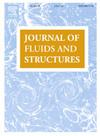升沉和俯仰翼型的完全被动能量收集:流体流动中的振荡响应模式和涡旋动力学
IF 3.4
2区 工程技术
Q1 ENGINEERING, MECHANICAL
引用次数: 0
摘要
本研究采用直接强迫浸入边界(DFIB)方法对naca0009、NACA0012和naca0015三种翼型在流场中的流激振动(FIV)行为进行了建模。分析研究了这些翼型在完全被动模式下的振动特性,具体条件包括固定翼型俯仰中心为12c,质量比为2.0,雷诺数Re=400和无阻尼条件下的气动阻尼系数均设为零(ba∗=baθ∗=0)。线性弹簧(ka∗)和扭转弹簧(kaθ∗)的刚度均定义为(2π/Ua∗)2。该研究检查振荡响应,涡旋模式,和能量转换效率的三种类型的翼型跨越12降低速度(Ua *)。振荡响应模式分为三个不同的区域:S- i, T-II和S- iii,而涡旋模式分为四种类型:“2P”,“2P + 2S”,“mP”和“P + S”。值得注意的是,所有三种翼型实现其峰值能量转换效率在Ua∗=1.63,与NACA0009达到43.9%,NACA0012达到44.2%,和NACA0015达到36.3%。本文章由计算机程序翻译,如有差异,请以英文原文为准。
Fully Passive Energy Harvesting from Heaving and Pitching Airfoils: Oscillation Response Patterns and Vortex Dynamics in Fluid Flow
This study employs the Direct-Forcing Immersed Boundary (DFIB) method to model the flow-induced vibration (FIV) behavior of three types of airfoils—NACA0009, NACA0012, and NACA0015—within a flow field. The analysis investigates the vibration characteristics of these airfoils in a fully passive mode under specific conditions, including a fixed airfoil pitching center at , a mass ratio of 2.0, a Reynolds number of Re, and undamped conditions with both aerodynamic damping coefficients set to zero (). The stiffness of the linear spring () and the torsional spring () are both defined as . The study examines the oscillatory responses, vortex patterns, and energy conversion efficiencies of the three types of airfoils across 12 reduced velocities (). Oscillation response patterns are categorized into three distinct regions: S-I, T-II, and S-III, while vortex patterns are classified into four types: ‘2P’, ‘2P + 2S’, ‘mP,’ and ‘P + S.’ Notably, all three airfoils achieve their peak energy conversion efficiency at , with NACA0009 reaching 43.9%, NACA0012 achieving 44.2%, and NACA0015 reaching 36.3%.
求助全文
通过发布文献求助,成功后即可免费获取论文全文。
去求助
来源期刊

Journal of Fluids and Structures
工程技术-工程:机械
CiteScore
6.90
自引率
8.30%
发文量
173
审稿时长
65 days
期刊介绍:
The Journal of Fluids and Structures serves as a focal point and a forum for the exchange of ideas, for the many kinds of specialists and practitioners concerned with fluid–structure interactions and the dynamics of systems related thereto, in any field. One of its aims is to foster the cross–fertilization of ideas, methods and techniques in the various disciplines involved.
The journal publishes papers that present original and significant contributions on all aspects of the mechanical interactions between fluids and solids, regardless of scale.
 求助内容:
求助内容: 应助结果提醒方式:
应助结果提醒方式:


